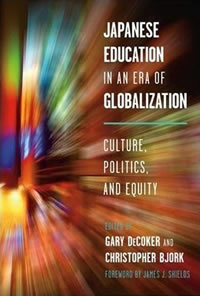BOOK REVIEW
Japanese Education in an Era of Globalization: Culture, Politics and Equity
Reviewed By Merri Rosenberg
 Japanese Education in an Era of Globalization: Culture, Politics and Equity
Japanese Education in an Era of Globalization: Culture, Politics and Equity
Edited by Gary DeCoker and Christopher Bjork. Foreword by James J. Shields.
Published by Teachers College Press, New York, NY 2013: 206 pp.
For many decades—especially through the 1980s—Japanese education was held up as the exemplar in comparison to what critics often saw as America’s progressive approach to an increasingly competitive global environment. Then, other voices assailed Japan’s purported rigidity and conformity as squelching student creativity, voices that gained additional attention during the reports of student suicides in the quest to gain entrance to Japan’s intensely selective universities.
This volume, which is a collection of essays examining the Japanese educational system from pre-school through the college-prep process, is an admirable effort to separate perception from reality, to provide an evidence-based account of how Japan’s educational system has changed, how it hasn’t, and what those implications are for the rest of the world.
Underlying the book is the concept that, shocking though it may have seemed to Americans’ accustomed to seeing “their” system as the model for the rest of the world, Japan may have been on to something. As Gary DeCoker writes, “Japan in the 1980s and 1990s, despite its ‘foreignness’ as a non-Westerns country, was viewed as a challenge and a potential model. Japanese education took on many meanings as Americans confronted the idea that Japan’s economic boom might result in its surpassing the United States in education, wealth and ultimately influence.”
The picture, of course, was more complex than that. Certainly the disturbing reports of bullying and teen suicides were seen as a social challenge to reduce some of the pressure on vulnerable adolescents. What emerges through these chapters, though, is the delicate tension Japanese educators confront, between maintaining the collective, group identity while trying to develop a stronger sense of the individual.
As Diane M. Hoffman writes, “at the level of official discourse (such as that driving Japanese education policy reform) one finds ample reference to a perceived need for the supposed collective or group-oriented Japanese self to change, to become more independent, individualistic, creative and so forth…What may be a tension between individualist and interdependent models of self at the official level of discourse dissolves at the informal level of practice, raising questions as to how certain constructions of Japanese culture gain legitimacy (and perhaps political utility) while others remain unrecognized but perhaps more powerful at the level of ordinary practice of teaching and learning.”
And it is perhaps this struggle between official doctrine, and in-the-classroom realities, that makes this especially relevant to American educators who are currently attempting to reconcile directives from the state and national education departments on standards and curriculum with what’s really going on in the schools.
There are plenty of teachable moments here, from resistance and responsiveness to change, and how that’s translated, that could help American teachers and administrators navigate the current transitions.
